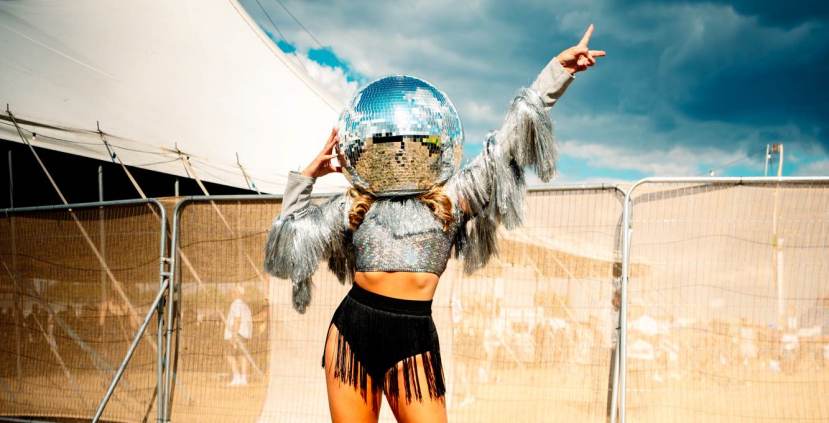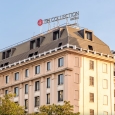
There’s something magnetic about UK summer music festivals—and it’s not just the lineups. It’s the promise of a day where life loosens its grip and joy takes the lead. Whether it’s the collective rush of a garage drop at KISSTORY, the cinematic sprawl of Alexandra Palace at Kaleidoscope, Superboxx at Rochester Castle: part disco revival, part soul sanctuary against ancient stone, or the nostalgic high of Uptown in Norwich, these festivals offer more than entertainment. They offer return—to memories, to movement, to moments where strangers become backup singers and music becomes a time machine. A chance to lose track of hours and rediscover a rhythm that doesn’t rely on Wi-Fi, only speakers and a sky.

At a time when so much in life feels curated, digital, and distant, these festivals are a return to something real. You’re not anyone’s manager or carer or inbox-clearer—you’re just a body in a crowd, singing a lyric you didn’t know you still remembered. The kind of lyric that lives in muscle memory. And it’s the people. It’s the collective decision everyone makes to show up open-hearted. To dance like no one’s filming. To sing like the words matter. This is the kind of music that stays with you, and these festivals offer the rare chance to feel it again—in full colour, in public, surrounded by others who remember too..

Perched high above the hum of the city, Alexandra Park offers one of London’s most expansive and cinematic backdrops was transformed into the stage for a festival that was as much about elevation of spirit as it was about physical altitude. Kaleidoscope isn’t your typical music festival. It feels more like a curated immersion into all that’s creatively vital about London, with its rolling green slopes, winding pathways, and grand views of the skyline providing a kind of natural amphitheatre for a day of art, music, and unfiltered joy.

From the top of the hill, the vista is staggering. Skyscrapers shimmered in the summer haze, a reminder of how far away the world of emails and errands felt from the warm, slow rhythm of the grass underfoot. People sprawled out across the lawn in small pockets—some with Prosecco in paper cups, others curled into the beats, eyes closed, sun-dazed. You could dip into a stage for a proper rave-up, then drift out to find a shady patch to hang out with your crew. It was that kind of day. Fluid, easy, full of sensory layers. And nowhere was that more felt than in the main bowl, where the dancing never stopped.

Elsewhere, the festival was divided into different realms of experience. The Hilltop Stage served nostalgia with style, led by Ministry of Sound Classical—a full orchestral reimagining of iconic dance tracks that had the crowd moving in that trance-like sway only live strings can produce. Then there was Soul II Soul, whose legendary status in London’s musical DNA brought out a cross-generational crowd who knew every line of “Back to Life” and sang it like it was scripture.

One of the standout sets of the day came from Fun Loving Criminals, joined by longtime collaborator DJ Mateo DiFontaine. Known for their slick blend of hip hop, funk, and noir-tinged storytelling, the New York outfit delivered with trademark swagger. DiFontaine—veteran DJ, crate-digger, and curator of downtown cool—added depth and edge to their set, threading in beats that gave the whole thing a cinematic pulse. It felt less like a festival slot and more like a scene from a great heist film—tight, stylish, and subversive in all the right ways.
The Fringe Stage offered a contrasting kind of energy: quick-fire stand-up, offbeat poetry, and monologues that made you laugh, blink, and think in the space of ten minutes. You could wander into a whimsical children’s theatre tent, then find yourself in a heated conversation about gentrification with a comic who’d just walked off stage. That was the beauty of it—Kaleidoscope is less a linear itinerary and more a sensory choose-your-own-adventure.
 The fact that it all unfolded in a park that felt simultaneously vast and intimate was no small part of its charm. You could dance with thousands to a DJ set, then disappear into a copse of trees for a ten-minute breather. Food trucks dotted the edges with everything from jerk chicken to vegan bao. And when dusk came and the palace behind the hill turned pink in the setting light, people didn’t rush to leave. They stayed. Talked. Laughed. Shared blankets and playlists.
The fact that it all unfolded in a park that felt simultaneously vast and intimate was no small part of its charm. You could dance with thousands to a DJ set, then disappear into a copse of trees for a ten-minute breather. Food trucks dotted the edges with everything from jerk chicken to vegan bao. And when dusk came and the palace behind the hill turned pink in the setting light, people didn’t rush to leave. They stayed. Talked. Laughed. Shared blankets and playlists.

What set Kaleidoscope apart wasn’t just its genre-blurring lineup or thoughtful staging—it was the sense that everyone was part of the fabric. That whether you came for the music, the comedy, the food, or just to sit in the grass and feel alive for a few hours, you belonged. It was London at its expansive best—layered, textured, and gloriously unpredictable.

KISSTORY on Blackheath wasn’t just a festival—it was a masterclass in nostalgia. Held in July, on the sweeping open common at Blackheath in southeast London, the day felt like a vibrant, open-air love letter to the golden years of garage, R&B, hip-hop, house, and old-school anthems. And it delivered, not with gimmicks or heavy-handed theming, but with an effortless authenticity that only KISSTORY could pull off.
Blackheath itself is an understated gem of a venue—its broad, breezy lawns and skyline views stretching to Canary Wharf make it feel like you’re attending a block party in the sky. People brought blankets, collapsible chairs, and coolers like they were turning up to a family function—albeit one with a thumping bassline, a world-class DJ lineup, and a booming MC on the mic shouting, “LONDON, ARE YOU READY?!”

And they were. From early afternoon, the crowd was already deep—early 2000s babies reuniting in bucket hats and tracksuits, couples reliving first dates soundtracked by Ashanti or Fatman Scoop, Gen Z fans rediscovering a sound they’d only heard on playlists curated by their older siblings. There was something universal in the way the beats hit, how certain basslines stirred something familiar in the body, like a reflex.
The Main Stage delivered hit after hit: Example brought undeniable energy with tracks like “Kickstarts” and “Changed the Way You Kiss Me,” while General Levy proved why he remains a livewire on any bill, his voice still razor-sharp, his flow unbroken. Barbara Tucker, a true house legend, gave one of the most euphoric vocal performances of the day—equal parts soulful sermon and dancefloor commandment.

The KISSTORY DJs held down the transitions with style. Their sets were a rollercoaster of hands-in-the-air moments: So Solid Crew classics, Destiny’s Child deep cuts, Armand Van Helden remixes, that era when Missy Elliot and Usher ruled the charts. Tracks didn’t fade out—they detonated. One banger into the next, like everyone had agreed ahead of time what the soundtrack to collective joy should be.
What really made KISSTORY sing, though, was the energy of the people. You saw old school ravers in glitter and cargo pants dancing next to teens on their first festival adventure. Groups choreographed routines they hadn’t pulled out in years. Random strangers swapped stories in the drinks queue: “Remember this one at Bagley’s?” “They played this at my wedding!” It wasn’t just about the music. It was a timeline. And everyone had their chapter.

Even as the sun dipped low and the final acts closed out the stage, no one seemed ready to go. It felt like a city exhale. London let its hair down that day—threw on its best trainers, raised its plastic pint glass, and raved like the next morning didn’t exist.

Superboxx at Rochester Castle isn’t just a festival—it’s a love letter to rhythm, staged in one of the most atmospheric locations in the southeast. Set against the looming Norman stone of the 12th-century fortress and the wide skies above the Medway, it’s a party with both heritage and heart. There’s a quiet kind of magic in watching DJs spin soul-drenched grooves while gulls wheel overhead and the sun hits the castle walls just so. It’s not trying to compete with the mega-festivals—it’s operating on a completely different frequency.
The crowd here doesn’t turn up to pose or posture. They come to move. They come for the music, the mood, the memories. Superboxx draws a musically curious, emotionally dialled-in audience—people who can sing along to Gwen McCrae and groove to a Salsoul edit without missing a beat. The day unfolds with a natural ebb and flow: the early hours are sun-soaked and social, with families and friends staking out spots across the grass, while the late afternoon brings the real heat as the DJs dig deeper and the basslines thicken.

The main arena pulses with joyful familiarity—an open-air stage that feels expansive without ever feeling anonymous. But it’s inside the Superboxx tent where the real heads gather. This is where crate-diggers and dancefloor veterans come to worship. The soundtrack is all killer, no filler: rare funk 45s, disco basslines with just the right crackle, house classics that still hit with warmth and weight. DJs like Craig Charles don’t just play records—they conduct emotional electricity. His set in Rochester was a masterclass in movement and memory, stitching together vintage grooves with fresh energy, turning the tent into a joyful, sweat-slicked mass of rhythm and release.

Later, Martin Kemp’s retro-charged “Back to the 80s” slot brought hands-in-the-air abandon and singalongs that carried all the way to the castle ramparts. This wasn’t nostalgia for its own sake—it was a shared celebration of tracks that still hit, decades on.

Superboxx at Rochester Castle proves that the best festivals aren’t always the loudest. Sometimes, they’re the ones that stay with you—not because they overwhelmed you, but because they understood you.

Uptown Festival in Earlham Park might be outside the London postcode, but it’s got the same heartbeat. There’s something about Uptown that’s quietly magnetic, something that draws you in without the flash or noise of the capital’s mega-festivals. Maybe it’s the sheer generosity of space or it’s the way the crowd arrives not just to party, but to soak—in sun, in sound, in that feeling of being right where you’re meant to be.
The vibe throughout the park was loose and glowing, helped along by the kind of lineup that speaks to broad, cross-generational love for music that moves you. No genre snobbery here—just big, singable tunes and crowd-commanding performers who know how to work a festival field. Notable acts from 2024 included the Earth, Wind & Fire Experience featuring Al McKay Allstars, The Christians, and The High Points. Additional performances by Dirty Havana, and The Funky Stuff added to the day’s musical variety.

While the main stage offered sweeping singalongs and euphoric mass moments, the tent was where the beats got deeper and the rhythm a little more raw. A steady stream of festivalgoers ducked in throughout the day, drawn by the unmistakable sound of funk breaks, soul cuts, disco grooves, and rare edits delivered by DJs who understood the assignment: keep people moving, keep the vibe warm, and don’t let a single beat go to waste.
Inside, it was all colour and sweat and sound. The Earth, Wind & Fire Experience featuring Al McKay Allstars had earlier filled the main field with glorious brass and silky vocals, but in the tent, it was DJs like Craig Charles and his Funk & Soul Club set who turned grooves into gospel. Charles spun with infectious joy, blending deep funk cuts and classic Northern Soul bangers with the timing of a veteran and the grin of someone who still can’t believe he gets to do this for a living. Later, Martin Kemp’s “Back to the 80s” DJ set had hands in the air and nostalgia rising like steam. There were no walls in that tent, just sound and motion.

Between sets, people sprawled out on picnic blankets or strolled between food trucks, casually debating whether that last track was better live or on vinyl. No rush. No pressure. Just sound, sun, and the low hum of joy in the air. The VIP area enhanced the festival experience with exclusive amenities such as a dedicated VIP stage, premium bar access, gourmet food outlets, and comfortable seating arrangements. Attendees enjoyed expedited entry through a VIP access lane, access to posh restrooms, and unique photo opportunities, all contributing to a luxurious and relaxed environment.

Uptown isn’t flashy—but that’s exactly why it works. It remembers what festivals used to be: gatherings, not spectacles. And in doing so, it gives people something that feels rare now—a space to just be. To dance like no one’s watching, even when they are. To shout lyrics at the sky. It offers a space to be casual and a bit hedonistic, to rediscover songs that lived on burnt CDs and to dance to grooves that never got old. It’s a festival that understands its audience: musically literate, joy-seeking, and emotionally tuned in.

If previous years were anything to go by, the next editions of KISSTORY on Blackheath, Kaleidoscope at Alexandra Palace, Superboxx at Rochester Castle, and Uptown Festival in Norwich promise to be just as electric, heartfelt, and unmissable.

There’s something almost sacred about the way the UK comes alive in the summer. Not just because the clouds finally part or the beer gardens spill into the streets, but because, for one fleeting season, music becomes the collective pulse of a city—and nowhere is that felt more than at festivals like Kaleidoscope, KISSTORY, Superboxx and Uptown. These aren’t just events to tick off a calendar. They’re full-body flashbacks, reunions with old selves, celebrations of the people we were—and still are—when the right song hits at the right time.

